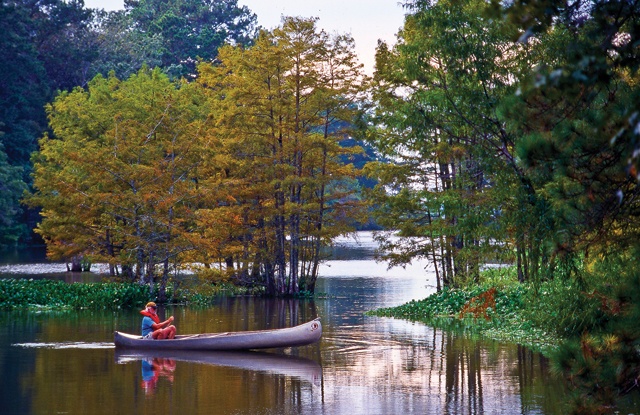Every fall something magical happens at Martin Dies Jr. State Park. Deep in the East Texas Piney Woods, the calm, glassy waters of B.A. Steinhagen Lake reflect the changing of the seasons. From the sweet gum and maple-lined banks to the bald cypress punctuating the lake’s scenic expanses, fall casts a warm palette of reds, oranges and yellows throughout the park.
Located at the northern edge of the Big Thicket near Jasper, two hours northeast of Houston, the park has several units, all accessible via U.S. Highway 190, which bisects the lake on a scenic two-mile stretch of road.
For me, this time of year is particularly enchanting for hiking the park’s wooded nature trails. It’s a time to slow down and take pause, as nostalgic sights and sounds of fall abound. The seasonal songs of migratory birds harmonize with the percussive crunch of newly fallen leaves beneath your feet as the gently rustling canopy applauds overhead.
Among the park’s 705 acres, my favorite spot for fall color is the Island Trail—a remarkable 0.8-mile loop amid stands of red maple, sweet gum and a variety of hardwoods. Along the trail, I’m able to glimpse views of wetland areas that cradle the island. Don’t miss the elevated wooden footbridge connecting the island to the wildlife management area that adjoins the park. “From this bridge there is a panoramic view of the foliage,” says Park Superintendent David Weeks.
While crossing the bridge, keep a keen eye out for the occasional bald eagle soaring overhead.
Looking from land is just one way to enjoy the seasonal color. The park’s centerpiece, B.A. Steinhagen Lake, beckons kayakers and canoeists to roam up to 16 miles of designated paddling trails or embark on their own exploration of the meandering backwater sloughs. Like the overland trails, a synchronous soundtrack of wind and gentle waters rushing under the canoe kindle a calming effect. The lake is surrounded by pristine hardwoods flaunting bursts of color and dotted with spectacular stands of rust-colored bald cypress trees and a patchwork of small islands.
Just north of the park, the confluence of the Angelina and Neches rivers forms a swampy labyrinth known as The Forks. “It’s an undeveloped river-bottom habitat that is rare to find these days,” says Weeks. The park offers canoe rentals and guided canoe trips through The Forks area.
The park’s trails, inlets and wetland areas are ripe with recreational opportunities. Campsites line the banks of the lake, offering a relaxing, shaded retreat. Those who like their nature on two wheels can bring bikes for use on the trails and park roads. Anglers will appreciate the various fishing amenities. The park has five piers and numerous bank fishing opportunities for visitors, and five boat ramps for boaters to access the lake, says Weeks. The popular species of fish caught are catfish, crappie and bass.
Whether you drive up for the fall color or settle in for a weeklong camping trip, you’ll enjoy the quiet splendor of Martin Dies Jr. State Park.
——————–
Eric Pohl is a writer/photographer in Austin.


